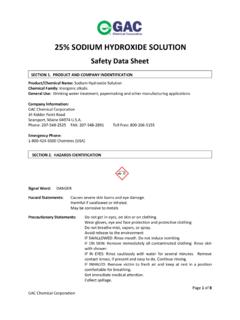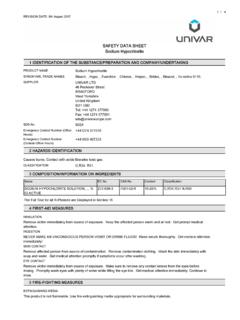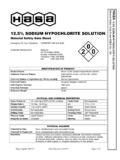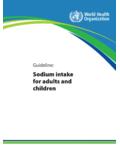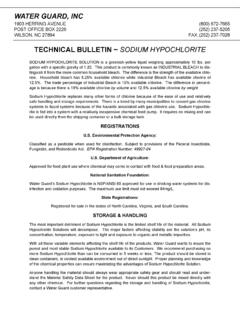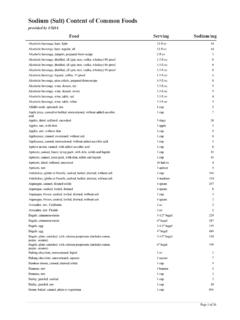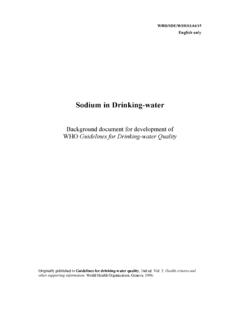Transcription of Safety Data Sheet Sodium Hypochlorite, 12.5%
1 Safety Data Sheet Sodium hypochlorite , SDS Revision Date: 05/06/2015 Page 1 of 8 1. Identification Product identifier Product Identity Sodium hypochlorite , Alternate Names Sodium hypochlorite , Relevant identified uses of the substance or mixture and uses advised against Intended use Laundry Bleach Application Method See Technical Data Sheet . Details of the supplier of the Safety data Sheet Company Name Gurtler Industries, Inc. 15475 South LaSalle St. South Holland, IL 60473 US Emergency 24 hour Emergency Telephone No. (708) 331-2550 Customer Service: Gurtler Industries, Inc. INFOTRAC - (800) 535-5053 2. Hazard(s) identification Classification of the substance or mixture Skin Corr/Irr. 1C, H314 Causes severe skin burns and eye damage Label elements Using the Toxicity Data listed in section 11 and 12 the product is labeled as follows.
2 Danger H314: Causes severe skin burns and eye damage [Prevention]: P260: Avoid breathing gas/mist/vapours/spray P264 Wash thoroughly after handling. P273: Avoid release to the environment. Safety Data Sheet Sodium hypochlorite , SDS Revision Date: 05/06/2015 Page 2 of 8 P280: Wear protective gloves/eye protection/face protection. [Response]: P304+P340 IF INHALED: Remove victim to fresh air and keep at rest in a position comfortable for breathing. P303+P361+P353 - IF ON SKIN (or hair): Take off immediately all contaminated clothing. Rinse skin with water/shower. P305+351+338 IF IN EYES: Rinse continuously with water for several minutes. Remove contact lenses if present and easy to do - continue rinsing. P310 Immediately call a POISON CENTER or doctor / physician. P321 Specific treatment (see information on this label).
3 P301+P330+P331 IF SWALLOWED: Rinse mouth. Do not induce vomiting. P362 Take off contaminated clothing and wash before reuse. [Storage]: Store locked up. Store in corrosive resistant container with resistant inner liner. [Disposal]: P501: Dispose of contents/container to an approved waste disposal plant. 3. Composition/information on ingredients This product contains the following substances that present a hazard within the meaning of the relevant State and Federal Hazardous Substances regulations. Ingredient/Chemical Designations Weight % GHS Classification Notes Sodium chloride CAS Number: 7647-14-5 5-20 No Data available [1] Sodium hypochlorite CAS Number: 7681-52-9 10-20 H314 [1] Sodium hydroxide CAS Number: 1310-73-2 <1 H290, H314, H318 [1] Water CAS Number: 7732-18-5 60-85 No Data available; no phrases apply [1] In accordance with paragraph (i) of , the specific chemical identity and/or exact percentage (concentration) of composition has been withheld as a trade secret.
4 [1] Substance classified with a health or environmental hazard. [2] Substance with a workplace exposure limit. [3] PBT-substance or vPvB-substance. *The full texts of the phrases are shown in Section 16. 4. First aid measures Description of first aid measures General In all cases of doubt, or when symptoms persist, seek medical attention. Never give anything by mouth to an unconscious person. Inhalation If inhaled, remove victim to fresh air. If not breathing, give artificial respiration. If breathing is difficult, give oxygen. Get medical attention Safety Data Sheet Sodium hypochlorite , SDS Revision Date: 05/06/2015 Page 3 of 8 Eyes In case of contact, immediately flush eyes with plenty of water for at least 15 minutes. Remove contact lenes, if present and easy to do. Continue rinsing. Get medical attention immediately.
5 Skin In case of contact, immediately flush skin with plenty of water for at least 15 minutes. Remove contaminated clothing and shows. Wash clothing before reuse. Thoroughly clean shoes before reuse. See physician if irritation persists. Ingestion If swallowed, DO NOT induce vomiting unless directed to do so by medical personnel. Get medical attention immediately. If victim is fully conscious, give a cupful of water. Never give anything by mouth to an unconscious person. Rinse mouth. 5. Fire-fighting measures Extinguishing media Water fog. Foam. Dry chemical powder. Carbon dioxide. Special hazards arising from the substance or mixture During fire, gases hazardous to health may be formed. Advice for fire-fighters Self-contained breathing apparatus and full protective clothing must be worn in case of fire.
6 Move containers from the fire area if you can do so without risk. Use water spray to cool adjacent fire exposed containers. Product will not burn but may splatter if temperature exceeds boiling point. 6. Accidental release measures Personal precautions, protective equipment and emergency procedures Put on appropriate personal protective equipment (see section 8). Keep unnecessary personnel away. Keep people away from and upwind of spill/leak. Keep out of low areas. Environmental precautions Do not allow spills to enter drains or waterways. Use good personal hygiene practices. Wash hands before eating, drinking, smoking or using toilet. Promptly remove soiled clothing and wash thoroughly before reuse. Methods and material for containment and cleaning up Large Spills: Stop the flow of material if this is without risk.
7 Use water spray to reduce vapors or divert vapor cloud drift. Dike the spilled material, where this is possible. Absorb spillage to prevent material damage. Use a non-combustible material like vermiculite, sand or earth to soak up the product and place into a container for later disposal. Prevent entry into waterways, sewer, basements or confined areas. Following product recovery, flush area with water. Small spills: Wipe up with absorbent material ( cloth, fleece). Clean surface thoroughly to remove residual contamination. 7. Handling and storage Safety Data Sheet Sodium hypochlorite , SDS Revision Date: 05/06/2015 Page 4 of 8 Precautions for safe handling Do not taste or swallow. Do not get in eyes, on skin or on clothing. Avoid breathing vapor or mist. Use only with adequate ventilation. Wash thoroughly after handling.
8 Prevent product contamination. Keep only in the original container. Store in tightly closed container Observe all labeled safeguards until container is cleaned, reconditioned or destroyed. Avoid contamination. See section 2 for further details. - [Prevention]: Conditions for safe storage, including any incompatibilities Handle containers carefully to prevent damage and spillage. Store in tightly closed container. Store in cool, dry, well ventilated area. Store out of direct sunlight in a cool, well ventilated place. Store in original container. Incompatible materials: acids, reducing agents Specific end use(s) No data available. 8. Exposure controls and personal protection Control parameters Exposure CAS No. Ingredient Source Value 1310-73-2 Sodium Hydroxide OSHA 2mg/m3 ACGIH 2mg/m3 NIOSH 2 mg/m3 ceiling Supplier No Established Limit 7681-52-9 Sodium hypochlorite OSHA 2mg/m3 STEL ACGIH No Established Limit NIOSH No Established Limit Supplier No Established Limit Exposure controls Respiratory Avoid breathing vapor or mist.
9 Where airborne exposure is likely or airborne exposure limits are exceeded (if applicable, see above), use NIOSH approved respiratory protection equipment appropriate to the material and/or its components. Eyes Wear a face shield, chemical goggles and have eye flushing equipment immediately Safety Data Sheet Sodium hypochlorite , SDS Revision Date: 05/06/2015 Page 5 of 8 available. Skin Chemical resistant, impervious gloves should be worn at all time of the following types; nitrile or neoprene. Wear a face shield, chemical goggles and chemical resistant clothing. Wear suitable protective clothing Protective shoes or boots. Engineering Controls Investigate engineering techniques to reduce exposures below airborne exposure limits or to otherwise reduce exposures. Provide ventilation if necessary to minimize exposures or to control exposure levels to below airborne exposure limits.
10 If practical, use local mechanical exhaust ventilation at sources of air contamination such as open process equipment. Eye wash facilities and emergency shower must be available when handling this product. Other Work Practices Use good personal hygiene practices. Wash hands before eating, drinking, smoking or using toilet. Promptly remove soiled clothing and wash thoroughly before reuse. See section 2 for further details. - [Prevention]: 9. Physical and chemical properties Appearance Clear, straw-yellow to greensih liquid Odor chlorine Odor threshold Not Measured pH + Melting point / freezing point -150F Initial boiling point and boiling range >212F Flash Point Not Measured Evaporation rate (Ether = 1) Not Measured Flammability (solid, gas) Not Applicable Upper/lower flammability or explosive limits Lower Explosive Limit: Not Measured Upper Explosive Limit: Not Measured Vapor pressure (Pa) Not Measured Vapor Density Not Measured Specific Gravity Solubility in Water Completely soluble Partition coefficient n-octanol/water (Log Kow) Not Measured Auto-ignition temperature Not Measured Decomposition temperature Not Measured Viscosity (cSt) <50 cps Other information No other relevant information.

